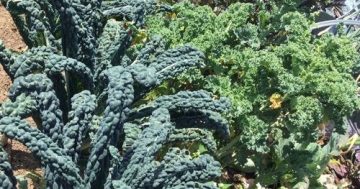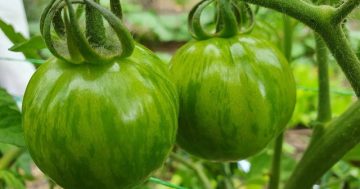
Winter lettuce planted at the right time are thriving. Photo: Helen Lynch.
The vegetable garden certainly knows it is mid winter.
Intermittent cold snaps and very cold winds see the Brussel sprouts begging to be harvested. The rhubarb has finally started to die back, the soft greens and even the leeks look like they just can’t get out of the cold wind quick enough.
Nearly every plant has squeezed up its roots and almost stopped growing in protest at the poor weather – occasional warm, still, sunny days not withstanding.
The only vegetables that are treating the cold with disdain in the Wynlen House garden at the moment are the choi joi, a most robust member of the Asian greens family (Brassicas). They have almost doubled in size over the last three weeks, and unlike other members of the choi group they are equally delicious cooked in a stir fry or fresh in a salad.

A kale umbrella in the garden. Photo: Helen Lynch.
Over the last few years gardeners in our cold climate region haven’t really had to worry too much about winter watering. Lack of sun has been more of a problem. Asking anyone about their last pumpkin crop is a conversation that usually ends in tears.
However, with global ocean warming, according to BoM, we are heading towards El Niño and the whole of Australia, including our region, is most likely to experience below median rainfall at least until September.
This means that time spent checking, repairing or investing in irrigation measures won’t be wasted. In fact incorporating regular watering into the garden regime over winter, will keep the garden growing.
Remember, winter watering does not need to be a long soak that is often necessary in the summer garden. In cold winter temperatures evaporation is very slow as well as plant growth.
Plants grow less quickly during the cooler months, so they don’t require as much moisture to support their stems and leaves. A good hand water may be all that is needed.

Choi job brassica is growing fast for use as a winter green. Photo: Helen Lynch.
Watering earlier in the day rather than late in the afternoon or evening is preferable. This gives the plants time to process the water throughout the day and dry before the colder temperature hits at night. Watering them at night can mean the water will sit in the roots and cause issues like rot, insects or fungal growth in the plants.
Planting some vegetables now is still possible but only as seedlings. Soil temps are still too cold for seed germination. BoM is also predicting above median minimum and maximum day and night time temperatures for winter, mind you most of us in our cold climate region haven’t noticed this so far.
However, it is certainly worth taking a chance and planting a little more than you would normally do right now. The slightly warmer predicted temperatures will ensure you have more vegetables to harvest over the months to follow.
What about planting two seedlings of each of your favourite cold season vegetables every week until the end of winter? Most of the Brassicas can be planted now, broccolini/broccoli, kale, cabbage, cauliflower; as seedlings should grow slowly but steadily even without frost protection.
If you get them in the ground now, they will be ready for eating from mid-spring to early summer. You may start seeing Brussel sprouts seedlings in nurseries. In our cold climate this is not the time to be planting. Brussel sprouts have to be started in late summer and are essentially a once a year crop.
Other seedlings that can be planted now include many of the Asian greens (except for wombok – wait until spring), spinach, silverbeet, leeks and winter lettuces. All the soft greens will benefit from frost protection. Once again it is best to plant these as seedlings.
It is also time to plant asparagus crowns and strawberry plants and keep an eye on the garlic patch. Any leaf discolouration at this time of year may be due to a nutrient deficiency. A regular feed with a seaweed fertiliser or a homemade compost tea will be very beneficial.
The other great gardening activity at this time of year is to peruse seed catalogues and to start planning the spring and summer garden. This is a good time to be ordering more unusual and heirloom varieties of late spring and summer vegetables including potatoes, pumpkins and tomatoes.
Bronwyn Richards and Helen Lynch run Wynlen House Artisan Village Farm and Learning Centre, a small village organic market garden in Braidwood, NSW. Since 2006 they have grown and sold fresh vegetables, eggs, preserves and garlic and teach others to do the same.





















